Antibiotics in Cosmetics
In 1941, Howard Florey [1898-1968] and Norman Heatley [1911-2004] travelled from England to the United States to persuade the Americans to begin manufacturing penicillin. Their efforts were successful and by 1945 American production of penicillin had risen to over 640 billion units every year, dwarfing the output of other Allies such as the Great Britain and Australia. By then, the mass production of penicillin was considered so important to the war effort that some have called it the second Manhattan Project, a reference to the development of the atomic bomb.

Above: Penicillin production at the Commonwealth Serum Laboratories in Parkville, Victoria, Australia. By 1944, output there had reached 400 million units a week. This was more than the armed forces needed and Australia became the first country to provide injectable penicillin for civilian use.
Once the full medical effectiveness of penicillin had been widely realised many drug companies and research establishments began searching for other ‘anti-biotics’, a term attributed to Selman Waksman [1888-1973], the discoverer of streptomycin. Between 1942 and 1952 over three hundred new antibiotics were found, most of which were isolated from antibiotic-producing bacteria and fungi found in soil samples.

Above: 1951 Bristol-Myers included collecting packets and stamped addressed envelopes in their 1951 Annual Report so that its shareholders could collect soil samples from their locality and send them to the company.
This collective research meant that by 1953 the commercial production of antibiotics was one of the fastest growing product groups in the United States.
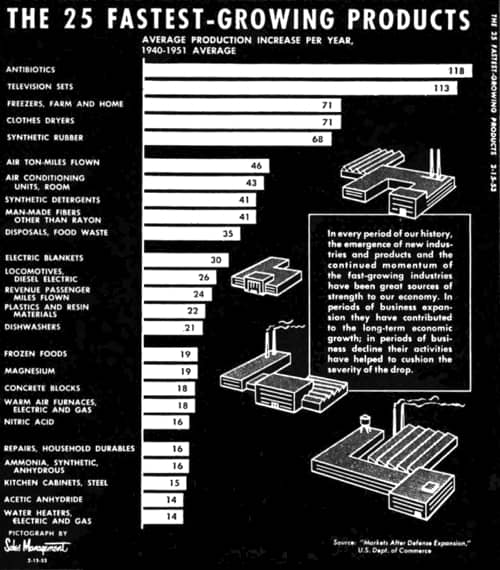
Above: 1953 The 25 Fastest-Growing Products (U.S.). Average production increase per year, 1940-1951 average.
As well as finding uses for these antibiotics in prescription medicines, over-the-counter (OTC) applications, such as throat lozenges, and non-medical uses, such as adding antibiotics to animal feed, were also developed.
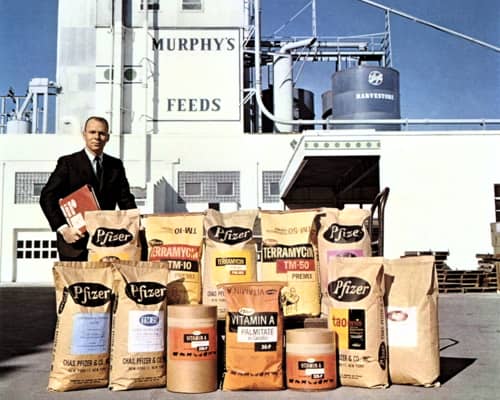
Above: 1965 A Pfizer representative with a range of antibiotic and vitamin additives for animal feed.
Antibiotics were also added to some cosmetics. A number of these – such as toothpastes, acne creams, anti-dandruff shampoos, nappy rash creams and deodorants – were already used to counteract the known or suspected effects of bacterial action. Cosmetic chemists thought that adding an antibiotic to some of these cosmetics might enhance their effectiveness and during the 1950s antibiotics like tyrothricin, bacitracin, polymyxin and neomycin were all suggested as possibilities. Most of this activity took place in the United States as legislation there allowed some products to be classified simultaneously as cosmetics and drugs. Other countries, such as the Great Britain, had legislative restrictions that did not allow for this possibility.
As well as acne treatments – which I will not cover here as they are a topic on their own – antibiotics were also added to dentrifices and deodorants in the 1950s and 1960s.
Dentrifices
Although the exact cause of tooth decay had not been established by 1950 the general consensus was that it was due to acid produced by oral bacteria. Working on this principle, a number of studies were undertaken to see if penicillin would reduce the incidence of dental caries. Their conclusions varied: some showed a positive effect but many did not. In 1950, despite the inconclusive results, the Andrew Jergens Company got permission from the American Food and Drug Administration (FDA) to market Dentocillan, a dentrifice containing penicillin (Segrave, 2010, p. 92). Penicillin breaks down in water, so Jergens sold Dentocillan as a tooth powder rather than as a tooth paste. The product was only available by prescription which limited its application and it was soon taken off the market. Lever Brothers also tried marketing an antibiotic dentrifice, releasing Shield toothpaste in 1953 containing the antibiotic tyrothricin. It too was only available for a limited time.
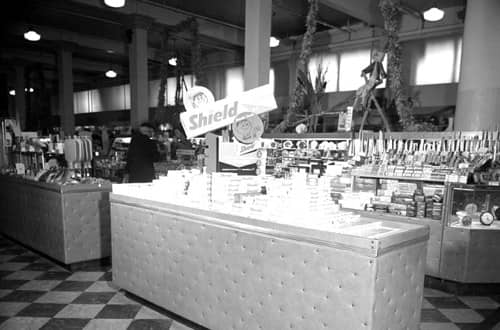
Above: Shield toothpaste on sale in Canada.
Although not a dentrifice, the recipe for an antibiotic mouthwash using gramacidin, a more active derivative of tryothricin, is worth noting (Rosenthal, 1957).
Antibiotic mouthwash
% Gramacidin 0.006 Pluronic F-68 0.500 Spearmint oil 0.050 Menthol 0.050 Cinnamon oil 0.010 FD&C Yellow No. 1 0.001 Saccharin sodium 0.150 Ethyl alcohol 25.000 Water 74.233 (Rosenthal, 1957, p. 374)
However, I have not found any instance of an antibiotic mouthwash in commercial production during this period.
Deodorants
In 1953, Shelley, Hurley and Nichols published a study on the role of bacteria in the production of body odour. Subsequent to this, Shelley and Cahn (1955) suggested that antibiotics could be used to control the bacteria and number of deodorants containing antibiotics were then developed for the American market most of which used either neomycin or tyrothricin.
Tryothricin: First isolated in 1939 by the French scientist René Dubois [1901-1982] when working at the Rockefeller Institute for Medical Research in New York. It is generally regarded as the first antibiotic to be used by modern medicine. It proved to be too toxic to be injected into the bloodstream but was used to treat surface wounds and skin infections.
Neomycin: This antibiotic was first isolated in 1949 by Hubert Lechevalier [1926-2015], a doctoral student working under Selman Waksman at Rutgers University in New Jersey. It is relatively toxic to humans so is primarily used in topical preparations.
Examples of American deodorants that contained antibiotics included: Yodora (McKesson & Robbins, Inc., Bridgeport, Connecticut); Deocin Deodorant-Antipersipirant Aerosol and Lotion (Upjohn Company, Kalamazoo, Michigan); Hi and Dri Deodorant-Antipersipirant Cream and Roll-On, and Top Brass Roll-On Deodorant (Revlon, Inc., New York); Neomycin Antiperspirant Lotion (Chas. Pfizer & Co., Inc., New York); and Biodorant Roll-On Deodorant (Helena Rubinstein, Greenvale, Long Island).
Many of these deodorants existed prior to antibiotics being added to them. For example, before tryothricin was included in the fomulation in 1955, Yodora was made as a perfumed, petroleum-based cream made with zinc oxide, boracic acid and sodium salicylate. Similarly, Revlon’s Hi and Dri deodorant was being sold well before neomycin sulphate was added to it in 1960.
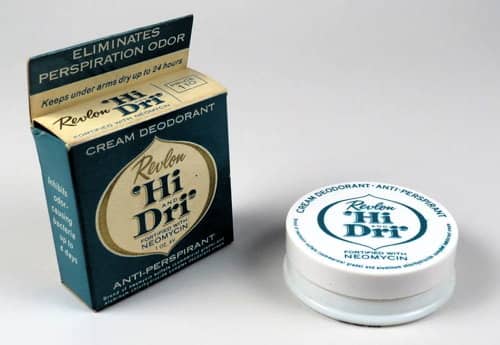
Above: Revlon Hi and Dri cream deodorant/anti-perspirant (Smithsonian).
There was a good deal of interest in the use of antibiotics in deodorants and recipes for them were included in cosmetic chemistry manuals. Two are included below:
Deodorant Cream
Neomycin (equivalent to 5 mg of neomycin sulfate) 0.35% Methylparaben 0.10% Water-washable, non greasy vanishing-type base. Sufficient quantity (Baker, 1962, p. 56)
Vanishing Cream
Neomycin Sulfate* 0.5 gm Cetyltrimethylammonium [sic] Bromide 1.0 gm Castor Oil 25.0 gm Beeswax 1.8 gm Lanolin 1.8 gm Cetyl Alcohol 5.0 gm Glycerol 10.0 gm Water 59.9 ml *Or tyrothricin 0.5 gm.
Directions: The oil phase is castor oil, beeswax, lanolin, and cetyl alcohol. The aqueous phase is neomycin sulfate (dissolved in water) or tyrothricin (suspended in water), cetyl trimethyl ammonium bromide, glycerol, and water. Heat each phase to 30°C, add the aqueous phase to the oil phase, stir well, remove from the water bath, continue to stir until congealed.(Baker, 1962, p. 57)
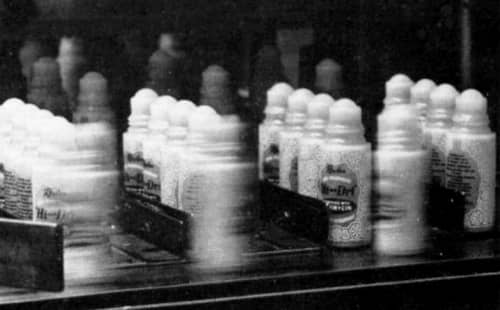
Above: 1961 Manufacturing Hi and Dri roll-on by Revlon.
Antibiotic resistance
In 1948, the American Medical Association (AMA) established a Committee on Cosmetics which became increasingly critical of the use of hormones, vitamins and antibiotics in cosmetics. The AMA opposed the indiscriminate use of topical antibiotics for a number of reasons, the most important being the increased risk of developing antibiotic-resistant microorganisms. Authorities around the world expressed similar concerns.
The American use of antibiotics in cosmetics declined during the 1960s, as cosmetic companies found alternative antiperspirants or embraced other antibacterials such as hexachlorophene, triclosan and triclocarban. Unfortunately, some of these antibacterials also proved to have safety concerns and/or have also shown signs of developing resistant strains of microorganisms.
See also: Hexachlorophene and Deodorants and Antiperspirants
Many antibiotics are still being used indiscriminately today and levels of antibiotic resistance has now reached crisis levels in a number of areas. Unfortunately, the development of new antibiotics is nowhere near the levels seen in the 1940s and 1950s.
Updated: 20th June 2017
Sources
Baker, W. B. (1962). Antibiotics. In M. G. deNavarre (Ed.), The chemistry and manufacture of cosmetics (2nd ed., Vol. I) (pp. 53-72). Princeton, NJ: D. Van Nostrand Company, Inc.
Gershon, S. D., Pokras, H. H., & Rider, T. H. (1957). Dentrifices. In E. Sagarin (Ed.). Cosmetics: Science and technology (pp. 296-360). New York: Interscience Publishers, Inc.
Jellinek, J. S. (1970). Formulation and function of cosmetics (G. L. Fenton, Trans.). New York: Wiley-Interscience.
Levy, S. B. (1992). The antibiotic paradox: How miracle drugs are destroying the miracle. New York: Plenum Press.
Rothman, S. (1961). Drugs in Cosmetics. J.A.M.A., 178(1), 38-42.
Rosenthal, M. W. (1957). Mouthwashes. In E. Sagarin (Ed.). Cosmetics: Science and technology (pp. 361-397). New York: Interscience Publishers, Inc.
Segrave, K. (2010). America brushes up: The use and marketing of toothpaste and toothbrushes in the twentieth century. Jefferson, NC: McFarland & Company. Inc.
Shelley, W. B., Hurley, H. J., & Nichols, A. C. (1953). Axillary Odor: Experimental study of the role of bacteria, apocrine sweat, and deodorants. Archives of Dermatology and Syphilology, 68(4), 430-446.
Shelley, W. B., & Cahn, M. M. (1955). Effect of topically applied antibiotic agents on axillary odor. J.A.M.A., 159(18), 1736-1738.
Stabile, T. (1969). Cosmetics: Trick or treat? (3rd ed.). New York: Arco Publishing Company, Inc.
Wainwright, M. (1990). Miracle cure: The story of penicillin and the golden age of antibiotics. Oxford: Basil Blackwell Ltd.
Wells, F. V., & Lubowe, I. I. (1964). Cosmetics and the skin. New York: Reinhold Publishing Corporation.
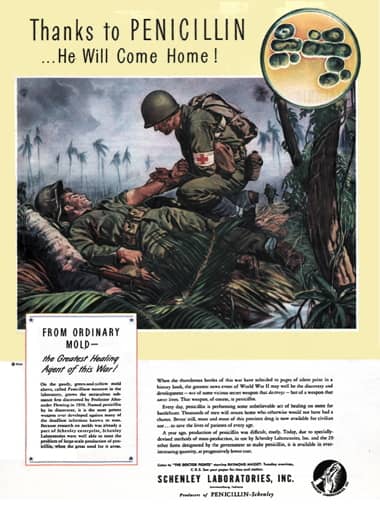
1944 Penicillin manufactured by Schenley Laboratories, Inc., Lawrenceburg, Indiana.
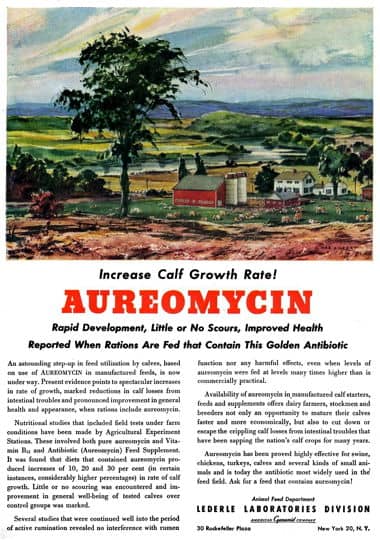
1952 Aureomycin feed supplement made by the Lederle Laboratories Division of American Cyanamid, New York.
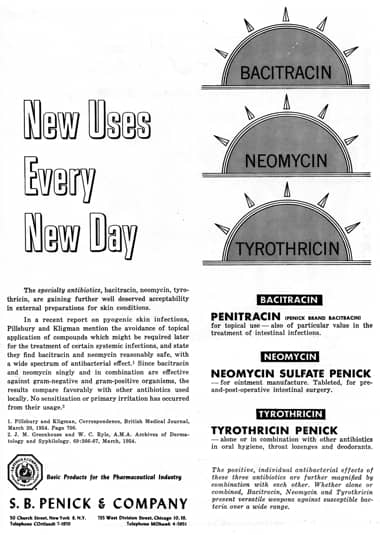
1952 Antibiotics from S. B. Penick & Company Used alone or in combination with other antibiotics in oral hygiene products, throat lozenges and deodorants.
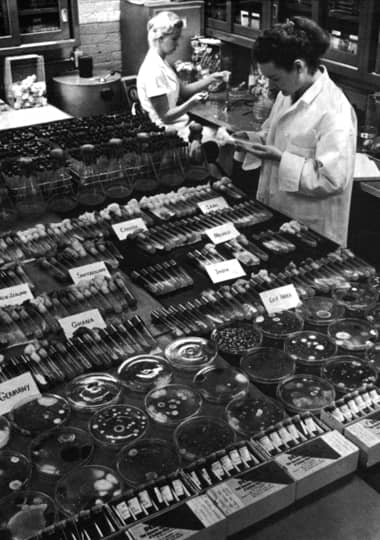
1959 A Pfizer laboratory testing soil samples from around the world for antibiotic producing microbes.
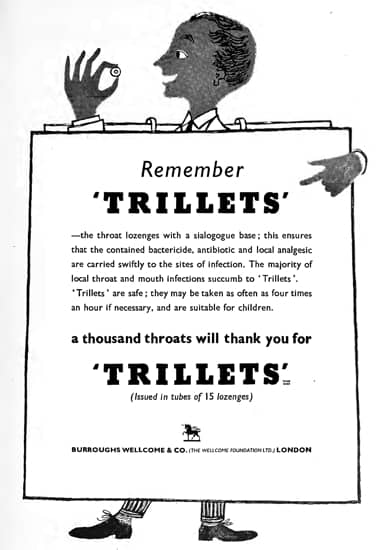
1960 Trillets by Burroughs Wellcome & Co. Introduced in 1959, these antibacterial, antibiotic and analgesic lozenges contained halopenium chloride, framycetin sulphate and xylocaine.
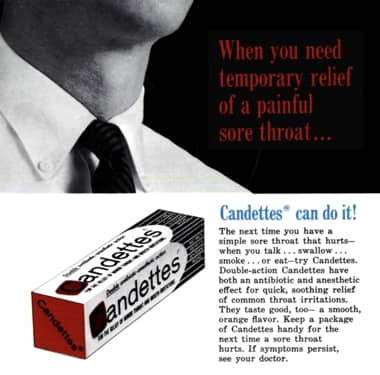
1963 Candettes, throat lozenges containing bacitracin, polymyxin B and benzocaine. In 1966, the FDA banned the manufacture and sale of OTC antibiotic lozenges in the United States having found no evidence that they were effective (Stabile, 1969, p. 182).
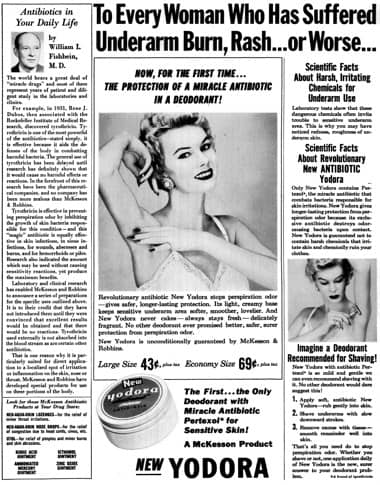
1955 Yodora deodorant with Pertexol (tyrothricin).
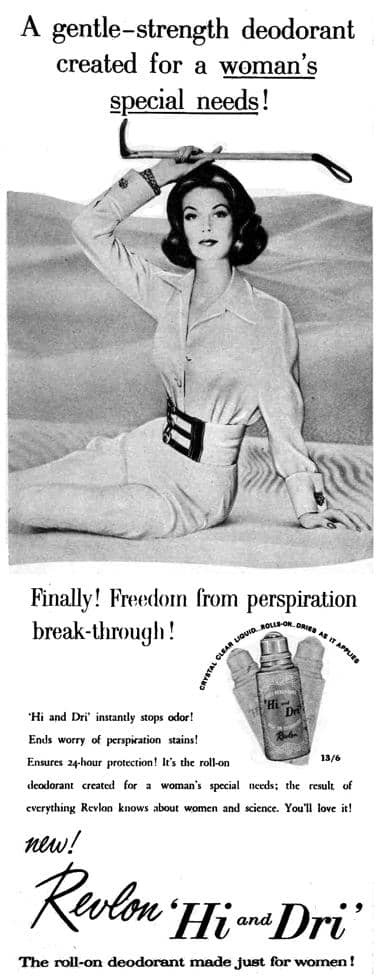
1959 Revlon Hi and Dri deodorant before an antibiotic was added in 1960.
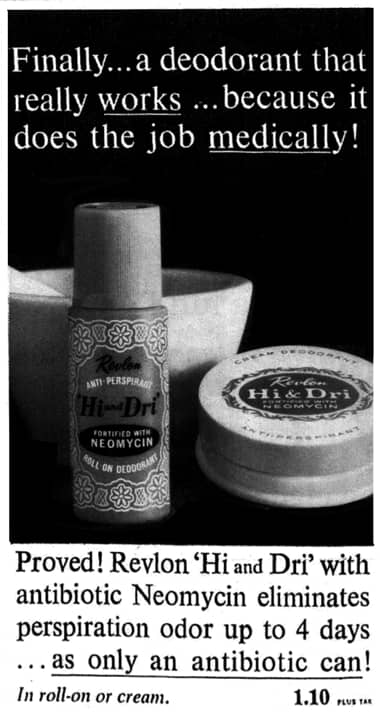
1963 Revlon Hi and Dri roll-on and cream deodorant/anti-perspirant with neomycin sulphate.
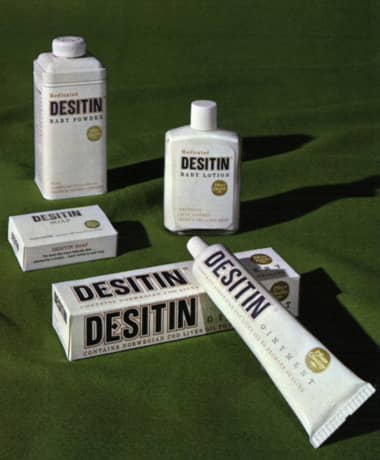
1963 Desitin baby products medicated with hexachlorophene rather than an antibiotic.

1966 Helena Rubinstein Super Biodorant deodorant. At some stage this deodorant contained neomycin sulphate.
